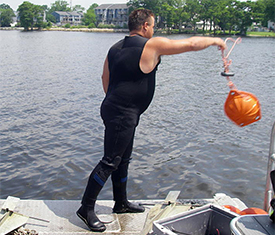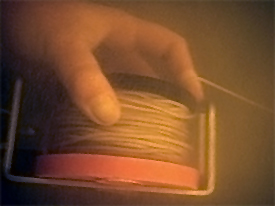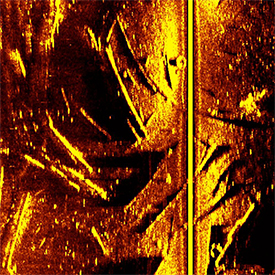
East Carolina University 2007 Field School
in Underwater Archaeology
12 June 2007
By Nadine Kopp
Today was my first day diving on the Neuse River, a nice change after the muddy waters of North Creek. As Jeremy detailed, yesterday we were on the Privateer remote sensing for areas to be investigated by the dive team. Today was our day to investigate the possible sites we had located the day before. Of the thirty contacts that we had made, these were cut down to seven after we took a closer look at them at the end of the day. Although these targets seem to be a small number for one day, we were doubtful at first of finishing all of them, since it would take time to locate the area of each contact and then search that area for the specific object that we had seen on the monitor from the side scan sonar.

Jeremy throws a buoy into the water to mark the location of side scan sonar contact to be checked out.
Last night we took the GPS readings of each of the targets that were to be searched. We sketched the objects in our field journals to be able to hopefully identify them underwater. One of the features of the program that we are using, SonarWiz, allows us to measure objects on the sonar image from one point to another. In this way we had a better idea of features of the objects that we were looking for, as the images are not very clear – sometimes it feels like looking at a Rorschach test.

The search pattern is controlled by the line reel held by one diver at the buoy, while the other swims in a 180° arch searching for the object on the river bottom.”
This morning we headed out to start looking at our targets. The manner in which we accomplished this was by throwing a weighted buoy off the boat when we reached the GPS location. After anchoring the boat, two people got in the water to perform a search of that area. One person stayed at the end of the buoy holding onto a line reel, while the other swam a 180° arc holding onto the other end. In this way we could cover half the area and then if the object was still not located, we could then search the other 180° arc of the area. Two tugs on the line from the reel holder signified that more line would be let out and that the line holder was to swim out, turn around and start searching in the other direction. Three tugs from the line holder communicated that the object had been located.

Jeremy and Nadine swim out towards the buoy marking a target for investigation.
As this was our first time doing this sort of search pattern, except for during our dive training, Michelle went under with one of us to ensure that the search went as planned. Jeremy was the first to go into the water. Their search was very short, as we were fortunate enough to have placed the buoy almost directly at the contact site. I went into the water with Michelle for the second contact. It took a lot longer to find the object, which turned out to be some metal cable and pipe. By the third dive Jeremy and I were on our own.

Side scan sonar image of a possible wreck site that proved to be merely some logs, evincing the difficulty in relying on these images without ground truthing (large view).
One of the interesting images that we came across yesterday on the sonar was something that possibly looked like a wreck (contact 16). Yesterday we sent the dive team to check it out. They reported that it was just a log over a cable, however, we were quite positive of what we saw, so decided to check it out ourselves. Since it was in an area where there was a pipeline, we were unable to anchor the boat there, making diving more of a hazard as the boat would be farther away if we encountered any problems. Therefore, Michelle and I got in the water to snorkel this find. Since all these targets are only located in approximately 6-9 feet of water, this was not a problem. We swam over to the site with the keen anticipation of locating the wreck that the other group had failed to find the previous day. To our disappointment, all that we found were various sizes of logs naturally positioned at angles that explained why we thought this was a boat.
We verified the remainder of the contacts before checking in with the survey team. Unfortunately none of our contacts produced anything of cultural significance, although there was one plank with a metal fastener in it. Once we met up with the others, we decided to check out the area of a known wreck, the Underwriter. This civil war era wreck is located near the Maola Milk Company wharf. We waited while the survey team used the side scan sonar to look for the wreck. The day was cut short by the approaching thunderstorms, but luckily we made it back to the dock just as the rain started. Even with the shortened day, we accomplished more than we had anticipated as the day began. Tomorrow we will likely move on to survey parts of the Trent River, which will hopefully produce more than pipes and logs.
Please feel free to contact us at mua@keimaps.com with any comments, questions, or suggestions during the weeks to come.
Return to Project Journal home page.

